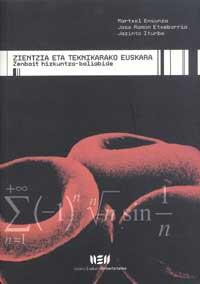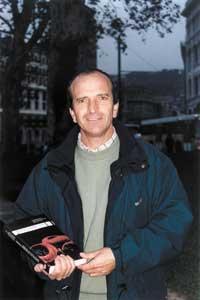Basque language correct in science and technique
According to the title itself, the book is formed by criteria and rules for the use of the correct Basque language in science and technology and José Ramón is clear to whom it is addressed: “We have made the book for users and not for languages. We believe that users are mostly physicists and mathematicians who work in institutes, ikastolas, university…”.
Therefore, with this book, we wanted to respond to the specific problems that users find in their daily work. “For example, how to read a formula that appears on the slate in Basque or what kind of writing to give a problem to be correctly written. We have tried to respond to these practical problems.”

Title: Title: Basque technical scientist. Some linguistic resources Authors: Martxel Ensunza, José Ramón Etxebrria, Editorial Jazinto Iturbe: UEU Pages: 458 458
In the opinion of José Ramón, although it is above all a reference book, in the first chapter there is a historical part that is nice to read. The other is, undoubtedly, consultable when one has any doubt.
A book of two parts
The book consists of two main sections. In the first, the reading of mathematical and physical expressions is analyzed. That is, how to read the mathematical formula that appears on the slate. According to José Ramón, “both in Spanish and in French and English, XIX. There is a long tradition that has been rooted since the creation of teachers' schools in the nineteenth century. The teachers received expressions in the normal school, that is, in the normalized school. It is clear that the Basques have not had a normal school of teaching and until our generation there has been no step towards normalization.”
The book is one more step on this path and one of its main contributions are the three rules that are given to read the symbols. The first rule refers to simple symbols, the second to structured symbols (when inside the symbol there are elements like the lim) and the third to the symbol chains.
In addition, they have explained how to read and model all the mathematical formulas that appear in baccalaureate and the first university year.
In the second part, the authors have worked on more concrete cases by chapters. Among them, they have worked techniques of lexical creation, logic of complex lexical units, problems that can cause the numbers in the language, magnitudes, units and abbreviations, elements of geometry, catalogue of symbols and signs and problems of chemistry. It should not be said that the book deals with the Basque language of science and technology in its entirety, analyzing orality, writing and the creation of new words.
Subject of the book
When it comes to wondering if the book has been prepared with the intention of covering a gap, José Ramón has dealt with the “prehistory of the book”. In his opinion, “this effort is not only ours. About 35 years ago the work was started with the creation of the ikastolas”.

For this reason, in the first part of the book, the works published from that beginning to the present have been analyzed. The first fruits of this work are mathematics books that were published about 20 years ago. For example, the mathematics book was produced by Mikel Zalbide and the beautiful work done by UZEI.
Martxel Ensunza, one of the authors of this book, collected the material when he began teaching technical Basque as a subject at the university. The UEU made three publications of this work, so specialized and surprising, and today it is exhausted.
After a long journey through the intention of publishing a new edition of this work, the authors have finally carried out a work of updating and complementing the book, collecting the latest norms of Euskaltzaindia and current trends.
In the words of José Ramón, “our work has been much facilitated in the last twenty years. Around the UEU there are two main working groups, one in the surroundings of Elhuyar in Donostia and another in the environment of the Faculty of Sciences in Leioa. Both publish quite a few times, so one knows the other. So, we make practically the same terminological options and I think the expressions are also quite standardized. I think it’s good that the scientific style is quite unified for users to consider concepts as normal.”
However, in addition to the works previously published in Basque, the languages of the area have also been taken into account. “We have carefully analysed the international languages of our environment, especially English, Spanish and French.”
Buletina
Bidali zure helbide elektronikoa eta jaso asteroko buletina zure sarrera-ontzian











